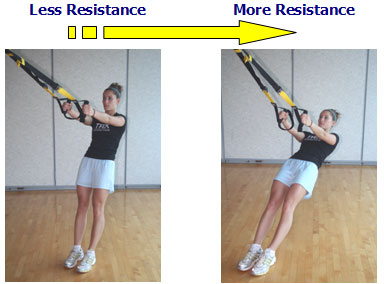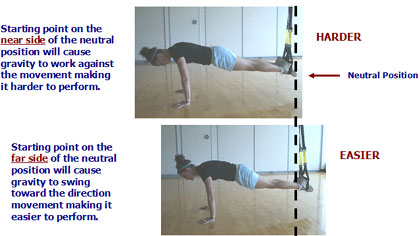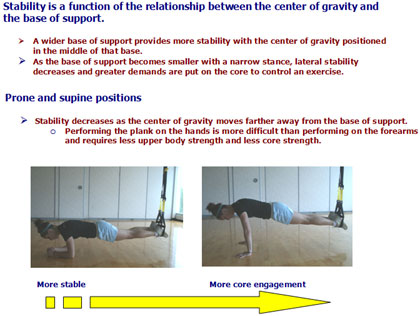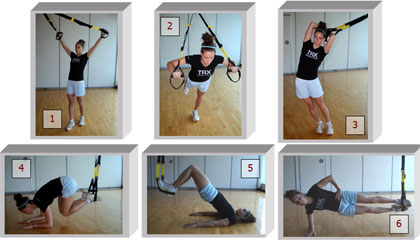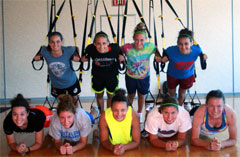 In
the rehabilitation and performance training settings there are a
variety of tools available to assist with achieving desired
objectives for a patient or client. One such functional tool, the
TRX Suspension Trainer™, has become quite popular not only in the
training setting but now in the rehab setting as well. The TRX
Suspension Trainer leverages gravity and the user’s bodyweight to
enable hundreds of exercises. It is designed to utilize suspension
training bodyweight exercise to develop strength, balance,
flexibility and core stability simultaneously.
In
the rehabilitation and performance training settings there are a
variety of tools available to assist with achieving desired
objectives for a patient or client. One such functional tool, the
TRX Suspension Trainer™, has become quite popular not only in the
training setting but now in the rehab setting as well. The TRX
Suspension Trainer leverages gravity and the user’s bodyweight to
enable hundreds of exercises. It is designed to utilize suspension
training bodyweight exercise to develop strength, balance,
flexibility and core stability simultaneously.
The TRX Suspension Trainer was invented by Randy Hetrick, a former
US Navy SEAL, to allow him and his SEAL teammates to maintain fitness
while deployed far from a conventional gym. Suspension Training
bodyweight exercise allows the individual to perform strength,
stability, and flexibility exercises supported in a suspended
position using body weight for resistance.
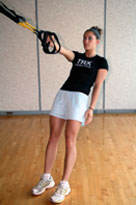 In
Suspension Training, the individual places their hands or feet into
the Suspension Trainer that is connected by a single anchor point
while the opposite end of the body is in contact with the ground.
“All Core-All the Time” is the principle concept of the TRX. This is
based on the assertion that training on the TRX will engage and
increase core muscle activity. In addition, exercising on the TRX
utilizes gravity and body movement to generate neuromuscular
responses to changes in body position. Other benefits of
Suspension Training include core muscle activation during closed
chain therapeutic exercises and can be completed in multiple planes
and angles. Studies have been conducted using adjunctive modalities
such as the Swiss ball and unstable conditions to study core muscle
recruitment (1, 2, 3, 4), but a review of the literature does not
provide peer reviewed studies to validate core activation specific
to Suspension Training. Further study is warranted to provide
evidence for the effectiveness of the TRX and to gain a better
understanding for the effective use of the TRX
Suspension Training device in the physical therapy and performance
training setting.
In
Suspension Training, the individual places their hands or feet into
the Suspension Trainer that is connected by a single anchor point
while the opposite end of the body is in contact with the ground.
“All Core-All the Time” is the principle concept of the TRX. This is
based on the assertion that training on the TRX will engage and
increase core muscle activity. In addition, exercising on the TRX
utilizes gravity and body movement to generate neuromuscular
responses to changes in body position. Other benefits of
Suspension Training include core muscle activation during closed
chain therapeutic exercises and can be completed in multiple planes
and angles. Studies have been conducted using adjunctive modalities
such as the Swiss ball and unstable conditions to study core muscle
recruitment (1, 2, 3, 4), but a review of the literature does not
provide peer reviewed studies to validate core activation specific
to Suspension Training. Further study is warranted to provide
evidence for the effectiveness of the TRX and to gain a better
understanding for the effective use of the TRX
Suspension Training device in the physical therapy and performance
training setting.
|
How to Use the TRX Suspension Trainer for Resistance and
Flexibility Training |
The TRX can be used safely indoors or outdoors on a non-slip surface
approximately 8’ x 6’ wide. Anchor points may include weight racks
and machines, chin-up and overhead bars, doors, railings and tree
branches; anything that can support bodyweight.
Anchoring the TRX Suspension Trainer
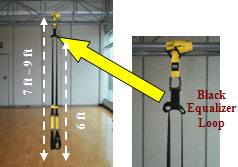 The anchor point
should be 7’ to 9’ high and strong enough to support
the weight of the patient with the Black Equalizer Loop
approximately 6’ off the ground. When the TRX is fully extended, the
foot cradles should be approximately 3” off the ground.
The anchor point
should be 7’ to 9’ high and strong enough to support
the weight of the patient with the Black Equalizer Loop
approximately 6’ off the ground. When the TRX is fully extended, the
foot cradles should be approximately 3” off the ground.
Adjusting Exercise Intensity
Exercises can be designed to include changes in resistance,
stability or both. This is very important when executing therapeutic
exercises with the rehab client.
3 Principles of Suspension Training to adjust difficulty on the TRX
Suspension Trainer
1. Vector Resistance® Principle – Resistance based on change in body
angle.
2. Pendulum Principle – Resistance based on position relative to the
anchor point.
3. Stability Principle – Change in the size and position and body’s
base of support. The wider the base, the more stability, the easier
the exercise.
Six exercise positions relative to the TRX Suspension Trainer
1. Standing facing the anchor point
2. Standing facing away from the anchor point
3. Standing sideways to the anchor point
4. Prone
5. Supine
6. Laying Sideways
Although there may be a
variety of tools available to the physical therapist,
athletic trainer or personal trainer, the TRX Suspension
System is the most versatile tool available which utilizes
Suspension Training to assist with achieving strength,
balance, flexibility, mobility and injury prevention needs.
It is durable as well and can be used safely for
clients of all ages with proper training. Workshops are available for the TRX
Suspension Trainer and advised prior to implementing in the
rehab or performance setting. Additional information can be
found at
Fitnessanywhere.com or by contacting Dino at
dino.laurenzi@uhsi.org
or Kevin at
kevin.conto@uhsi.org.
Advertisement
Below are handouts
of instructional exercises involving the TRX for core training,
upper body training, lower body training and
flexibility/mobility training which can be printed and
utilized for exercise instruction.
 TRX
Strength Exercises - Core Handout
TRX
Strength Exercises - Core Handout
 TRX
Strength Exericses - Upper Body Handout
TRX
Strength Exericses - Upper Body Handout
 TRX
Strength Exercises - Lower Body Handout
TRX
Strength Exercises - Lower Body Handout
 TRX Flexibility & Mobility
Handout
TRX Flexibility & Mobility
Handout
Last revised: June 18, 2010
by Dino Laurenzi, L-ATC, MA, MBA, TRX Trainer & Kevin Conto, MPT, ATC,
COMT, TRX Trainer
References
1. Behm DG, Anderson K, Curnew RS: Muscle force and
activation under stable and unstable conditions. J Strength
Cond Res 2002, 16 (3): 416-22.
2. Cosio-Lima LM, Reynolds KL, Winter C, Paolone V, Jones
MT. Effects of physioball and conventional floor exercises
on early phase adaptations in back and abdominal core
stability and balance in women. J Strength Cond Res.
17:721-725, 2003.
3. Marshall, P.W.M., and B.A. Murphy. Core stability
exercises on and off a swiss ball. Arch. Phys. Med. Rehabil.
86:242-249. 2005.
4. Moreside JM, Vera-Garcia FJ, and McGill SM. Trunk muscle
activation patterns, lumbar compressive forces and spine
stability when using the body blade. Phys Ther. 87: 153-163,
2007.


 TRX
Strength Exercises - Core Handout
TRX
Strength Exercises - Core Handout 
 In
the rehabilitation and performance training settings there are a
variety of tools available to assist with achieving desired
objectives for a patient or client. One such functional tool, the
TRX Suspension Trainer™, has become quite popular not only in the
training setting but now in the rehab setting as well. The TRX
Suspension Trainer leverages gravity and the user’s bodyweight to
enable hundreds of exercises. It is designed to utilize suspension
training bodyweight exercise to develop strength, balance,
flexibility and core stability simultaneously.
In
the rehabilitation and performance training settings there are a
variety of tools available to assist with achieving desired
objectives for a patient or client. One such functional tool, the
TRX Suspension Trainer™, has become quite popular not only in the
training setting but now in the rehab setting as well. The TRX
Suspension Trainer leverages gravity and the user’s bodyweight to
enable hundreds of exercises. It is designed to utilize suspension
training bodyweight exercise to develop strength, balance,
flexibility and core stability simultaneously. In
Suspension Training, the individual places their hands or feet into
the Suspension Trainer that is connected by a single anchor point
while the opposite end of the body is in contact with the ground.
“All Core-All the Time” is the principle concept of the TRX. This is
based on the assertion that training on the TRX will engage and
increase core muscle activity. In addition, exercising on the TRX
utilizes gravity and body movement to generate neuromuscular
responses to changes in body position. Other benefits of
Suspension Training include core muscle activation during closed
chain therapeutic exercises and can be completed in multiple planes
and angles. Studies have been conducted using adjunctive modalities
such as the Swiss ball and unstable conditions to study core muscle
recruitment (1, 2, 3, 4), but a review of the literature does not
provide peer reviewed studies to validate core activation specific
to Suspension Training. Further study is warranted to provide
evidence for the effectiveness of the TRX and to gain a better
understanding for the effective use of the TRX
Suspension Training device in the physical therapy and performance
training setting.
In
Suspension Training, the individual places their hands or feet into
the Suspension Trainer that is connected by a single anchor point
while the opposite end of the body is in contact with the ground.
“All Core-All the Time” is the principle concept of the TRX. This is
based on the assertion that training on the TRX will engage and
increase core muscle activity. In addition, exercising on the TRX
utilizes gravity and body movement to generate neuromuscular
responses to changes in body position. Other benefits of
Suspension Training include core muscle activation during closed
chain therapeutic exercises and can be completed in multiple planes
and angles. Studies have been conducted using adjunctive modalities
such as the Swiss ball and unstable conditions to study core muscle
recruitment (1, 2, 3, 4), but a review of the literature does not
provide peer reviewed studies to validate core activation specific
to Suspension Training. Further study is warranted to provide
evidence for the effectiveness of the TRX and to gain a better
understanding for the effective use of the TRX
Suspension Training device in the physical therapy and performance
training setting. The anchor point
should be 7’ to 9’ high and strong enough to support
the weight of the patient with the Black Equalizer Loop
approximately 6’ off the ground. When the TRX is fully extended, the
foot cradles should be approximately 3” off the ground.
The anchor point
should be 7’ to 9’ high and strong enough to support
the weight of the patient with the Black Equalizer Loop
approximately 6’ off the ground. When the TRX is fully extended, the
foot cradles should be approximately 3” off the ground.